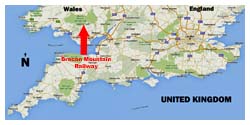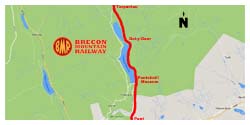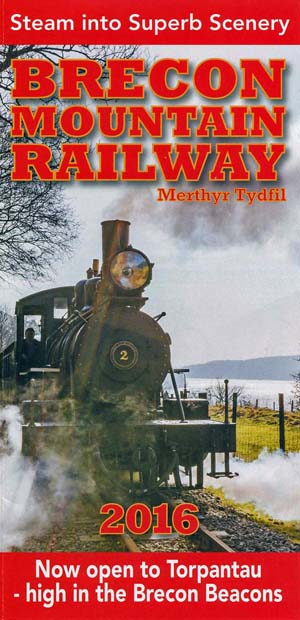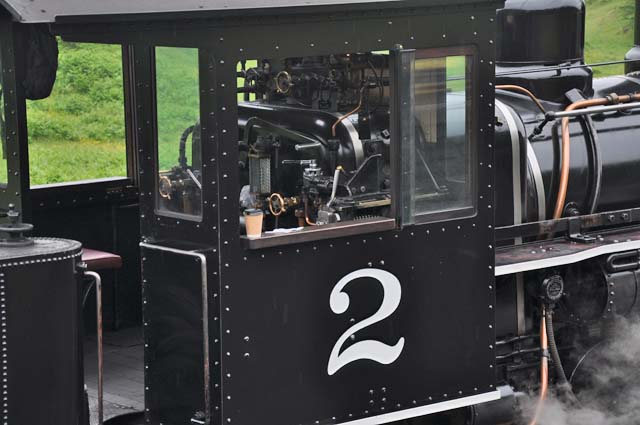
 Brecon Mountain Railway
Brecon Mountain Railway
Pant Station
Francis Terrace
Pontsticill
Merthyr Tydfil
Glamorgan
Wales
United Kingdom
N51.776060 W3.363540 (Parking lot entrance at Pant)
 The first thing to strike one about the Brecon Mountain Railway is their locomotive number 2, a Baldwin built locomotive. What's an American Baldwin engine doing in Wales? Not only that, but there's a replica Sandy River & Rangeley Lakes Railroad caboose here too. This equipment seems out of place here in Wales until you consider that the two foot railroads in Maine probably owe their choice of gauge because of the development of Welsh narrow gauge railways. This locomotive, plus examples of British and German engines, operate here in the Brecon Beacons National Park, or Parc Cenedlaethol Bannau Brycheiniog in Welsh, 519 square miles (1,344 square kilometres) of forested hills. The highest point, named Pen-y-Fan (pronounced pen-A-van), lies at 2,906 feet (886 metres) elevation.
The first thing to strike one about the Brecon Mountain Railway is their locomotive number 2, a Baldwin built locomotive. What's an American Baldwin engine doing in Wales? Not only that, but there's a replica Sandy River & Rangeley Lakes Railroad caboose here too. This equipment seems out of place here in Wales until you consider that the two foot railroads in Maine probably owe their choice of gauge because of the development of Welsh narrow gauge railways. This locomotive, plus examples of British and German engines, operate here in the Brecon Beacons National Park, or Parc Cenedlaethol Bannau Brycheiniog in Welsh, 519 square miles (1,344 square kilometres) of forested hills. The highest point, named Pen-y-Fan (pronounced pen-A-van), lies at 2,906 feet (886 metres) elevation.
The Brecon Mountain Railway gauge is 1 foot 11 3/4 inches, a typical Welsh narrow gauge commonly called two foot gauge. The railway itself climbs just 179 feet in 5 miles (8 kilometres) from the large combined station, gift shop, and workshop at Pant to a platform with run-around track at Torpantau. Trains depart from Pant, reversing at Torpantau, then stop at the Pontsticill Museum for 25 to 35 minutes before returning to Pant. There is a large parking area at Pant offering free parking for visitors to the railway.
During a visit in 2016 six steam locomotives and one diesel locomotive were discovered at the railway. Number 2 was operational with others possibly serviceable, under construction, or in storage at the museum or the Pant workshop.
 Number 2 - is a narrow gauge 4-6-2 Pacific type built in 1930 by Baldwin Locomotive Works in Philadelphia, USA, for the Eastern Province Cement Company of Port Elizabeth, South Africa, to haul limestone. The locomotive ran away and was wrecked in 1973. Written off by the insurance company the Brecon Mountain Railway purchased it as salvage. It was rebuilt to operating condition once more at the Pant workshop between 1993 and 1997.
Number 2 - is a narrow gauge 4-6-2 Pacific type built in 1930 by Baldwin Locomotive Works in Philadelphia, USA, for the Eastern Province Cement Company of Port Elizabeth, South Africa, to haul limestone. The locomotive ran away and was wrecked in 1973. Written off by the insurance company the Brecon Mountain Railway purchased it as salvage. It was rebuilt to operating condition once more at the Pant workshop between 1993 and 1997.
 "Graf Schwerin-Lowitz" - is a narrow gauge 0-6-2WT (Well Tank) with a tender built in 1908 by Arnold Jung Locomotivfabrik of Germany. It was operated by the Mecklenburg-Pommersche Schmalspurbahn until worn out then rebuilt in 1981 and given a new boiler in 1993. Due to its small size it's unable to pull trains on the stiff grade beyond Dol-y-Gaer. During summer 2016 the engine was found located inside the Pant workshop and may not be serviceable.
"Graf Schwerin-Lowitz" - is a narrow gauge 0-6-2WT (Well Tank) with a tender built in 1908 by Arnold Jung Locomotivfabrik of Germany. It was operated by the Mecklenburg-Pommersche Schmalspurbahn until worn out then rebuilt in 1981 and given a new boiler in 1993. Due to its small size it's unable to pull trains on the stiff grade beyond Dol-y-Gaer. During summer 2016 the engine was found located inside the Pant workshop and may not be serviceable.
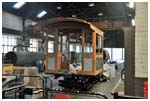 Number 1 - "Santa Teresa" will be a 2-6-2 Prairie when re-construction is complete. The engine was originally constructed by Baldwin as a 2-6-0 in 1897 for the Mogyana Railway in Brazil. They subsequently sold her to the Santa Teresa Sugar Mill where she was converted to 2 foot 6 inch gauge. Purchased in 2002 by BMR conversion construction is mainly complete but awaits completion of a new boiler at Pant.
Number 1 - "Santa Teresa" will be a 2-6-2 Prairie when re-construction is complete. The engine was originally constructed by Baldwin as a 2-6-0 in 1897 for the Mogyana Railway in Brazil. They subsequently sold her to the Santa Teresa Sugar Mill where she was converted to 2 foot 6 inch gauge. Purchased in 2002 by BMR conversion construction is mainly complete but awaits completion of a new boiler at Pant.
 Number 3 - construction has started on a replica Sandy River & Rangeley Lakes 2-6-2 Prairie based on drawings of SR&RL number 23.
Number 3 - construction has started on a replica Sandy River & Rangeley Lakes 2-6-2 Prairie based on drawings of SR&RL number 23.
 Number 4 - construction has started on a replica Sandy River & Rangeley Lakes 2-4-4 Forney engine based on drawings of SR&RL number 10.
Number 4 - construction has started on a replica Sandy River & Rangeley Lakes 2-4-4 Forney engine based on drawings of SR&RL number 10.
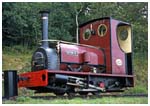 "Sybil" - is a 0-4-0ST built by Hunslet of Leeds in 1903. Sybil was used by the Pen-Yr-Orsedd Slate Quarry at Nantlle near Caernarfon until 1959. BMR purchased her in 1963 then once rebuilt was used to haul the first trains here in 1980 comprised of just 1 carriage. Not used since 1981 the locomotive was fully restored in 2012 with extensive boiler work carried out. Sybil rests in the museum at Pontsticill.
"Sybil" - is a 0-4-0ST built by Hunslet of Leeds in 1903. Sybil was used by the Pen-Yr-Orsedd Slate Quarry at Nantlle near Caernarfon until 1959. BMR purchased her in 1963 then once rebuilt was used to haul the first trains here in 1980 comprised of just 1 carriage. Not used since 1981 the locomotive was fully restored in 2012 with extensive boiler work carried out. Sybil rests in the museum at Pontsticill.
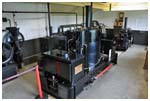 "Pendyffryn" - is a 0-4-0 vertical boiler locomotive built by De Winton & Company of Caernarfon in 1894 for the Pen-Yr-Orsedd Slate Quarry. The engine was purchased in 1965 and stored until completion of a full restoration by Pant workshops in 2012. "Pendyffryn" is located in the Pontsticill Museum.
"Pendyffryn" - is a 0-4-0 vertical boiler locomotive built by De Winton & Company of Caernarfon in 1894 for the Pen-Yr-Orsedd Slate Quarry. The engine was purchased in 1965 and stored until completion of a full restoration by Pant workshops in 2012. "Pendyffryn" is located in the Pontsticill Museum.
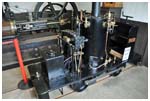 "Redstone" - is a 0-4-0 vertical boiler locomotive built by a Mr. Redstone, a foreman fitter at the Penmaenmawr Granite Quarry. It is a 1 foot 11 3/4 inch gauge replica of a 3 foot gauge De Winton used at the quarry. It was built for the quarry owners children in 1903 for use on a garden railway around their house then operated by Trefor Quarry near Porthmadog in the 1920's. It also was restored at Pant in 2012 and resides in the Pontsticill Museum.
"Redstone" - is a 0-4-0 vertical boiler locomotive built by a Mr. Redstone, a foreman fitter at the Penmaenmawr Granite Quarry. It is a 1 foot 11 3/4 inch gauge replica of a 3 foot gauge De Winton used at the quarry. It was built for the quarry owners children in 1903 for use on a garden railway around their house then operated by Trefor Quarry near Porthmadog in the 1920's. It also was restored at Pant in 2012 and resides in the Pontsticill Museum.
The Brecon Mountain Railway was conceived over 36 years ago when a search started to find a site to operate a steam tourist railway using various locomotives and equipment collected from Europe and further a field.
Merthyr Tydfil seemed ideal, located on the edge of the Brecon Beacons National Park with its beautiful mountains, lake, and forest scenery. At one time it was the greatest iron making town in the world and most of the earlier railways used rails rolled by its mills. It also witnessed in 1804 the trial run of the Trevithick locomotive, the first steam railway engine.
The site chosen was on the abandoned Brecon & Merthyr Railway opened originally in 1859 and finally closed in 1964. This railway fought its way through the Brecon Beacons using gradients and the Torpantau tunnel which at 1,313 feet above sea level is the highest railway tunnel in Great Britain. For the Brecon Mountain Railway the 5 mile stretch between Pant and Torpantau seemed suitable but difficulties were soon found. The scrap merchants had not only removed the track but also all the bridge girders and even the manhole covers. The ballast had been taken for road material and no buildings remained except for the shell of the signal box at Pontsticill and the station house which was used as a sheep shelter. It was then discovered that the only part of the railway still in the hands of British Rail was one bridge abutment, which they readily agreed to sell! The remaining land had been sold off and it took 5 years to obtain the rest from 12 different landowners. At Pant the old station site was not available so adjoining land was purchased for a deviation.
By 1978 the various planning and other consents had been obtained so construction began with the re-building of the station house and conversion of the adjoining waiting room into a small workshop. Then came a tin shed for storage and work started on the repair and replacement of the 7 bridges between Pant and Pontsticill. Track laying was commenced in 1979 but delayed for 2 months whilst a huge land slide near Pant was filled with a row of demolished terrace houses from Merthyr Tydfil.
Meanwhile the first carriage had been built at Pontsticill and "Sybil", a small slate quarry engine from North Wales had been prepared to haul trains.
The Site at Pant
 The car park is built on the site of the former railway branch into Dowlais and 80 feet below is the old London & North Western Railway (L&NWR) railway tunnel which closed in 1958, its 3 ventilation shafts (pepper pots) can still be seen lined across the back of the car park. Across the road are the disused Morlais Quarries which supplied limestone to the great iron works, again connected by rail. In fact there were railways everywhere, all built to serve the intense industrial activity generated by the iron works and mines in the area.
The car park is built on the site of the former railway branch into Dowlais and 80 feet below is the old London & North Western Railway (L&NWR) railway tunnel which closed in 1958, its 3 ventilation shafts (pepper pots) can still be seen lined across the back of the car park. Across the road are the disused Morlais Quarries which supplied limestone to the great iron works, again connected by rail. In fact there were railways everywhere, all built to serve the intense industrial activity generated by the iron works and mines in the area.
The main station at Pant was built and expanded between 1982 and 1993 to provide visitor facilities as well as a workshop and rolling stock storage. In addition to a cafe, shop, toilets, and booking office there are facilities for disabled visitors including ramps up to the platform where they can board a railway carriage designed to carry wheelchairs.
All railway maintenance is carried out by the railways own paid staff and in addition to routine repairs and servicing complete locomotive rebuilds are carried out not only for this railway but also for others as well. Although some of the workshop machinery dates back to the turn of the last century it still performs useful work. The wheel lathe was built in the 1890's and came from Southend Pier where it was used for turning tram car wheels. In addition to boiler making, tank, and cab riveting, wheel turning, and machining on the locomotives, carriages are also built. The five in use were all built here using the bogies from South African freight cars and couplings from the Isle of Man. The four observation saloons were designed here but the caboose was built to the original 1903 American drawings from the Sandy River & Rangeley Lakes Railroad in Maine.
The Line to the North
The first 600 yards the line, built to the narrow gauge of 1 foot 11 3/4 inches, follows a totally new alignment some of which was cut through solid rock.
The original line joins from the right whilst to the left far below may be seen the river Taf Fechan, the track bed of the branch from Pontsticill to Merthyr Tydfil, and the spoil heap of material excavated from the London & North Western Railways Morlais tunnel. On the hills beyond the gorge can be seen Vaynor Quarry, from which most of the track ballast for the Brecon Mountain Railway was obtained.
Across the valley, near a disused quarry, can be seen the village of Pontsticill. The line then enters a wooded cutting crossing several streams which tumble down the rocky hillside. North of the cutting the Taf Fechan reservoir is visible against a back drop of the three peaks of the Brecon Beacons. The middle peak is Pen-Y-Fan which at 2,906 feet, the highest point in South Wales. To the left is Corn Du and to the right Y Cribyn. At the boundary marker where the line enters the Brecon Beacons National Park are the remains of a felt works. The original standard gauge siding is still under the turf.
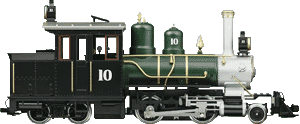 Approaching Pontsticill Station the Reservoir Dam can be seen. The Reservoir was constructed in 1927 and can hold 3,400 million gallons of water. The water covers the vicarage and 15th century Capel Taf Fechan, Bethlehem Congregational Chapel, some cottages, small holdings, and the land belonging to eight farms. In times of drought when the reservoir level is low the remains of some of these buildings appear above water level. On the valley floor below the dam a new water treatment works was completed in 1971. At Pontsticill Station the original signal box has been incorporated into a residential structure. The ballasted area to the right of the signal box was the site of an old turntable.
Approaching Pontsticill Station the Reservoir Dam can be seen. The Reservoir was constructed in 1927 and can hold 3,400 million gallons of water. The water covers the vicarage and 15th century Capel Taf Fechan, Bethlehem Congregational Chapel, some cottages, small holdings, and the land belonging to eight farms. In times of drought when the reservoir level is low the remains of some of these buildings appear above water level. On the valley floor below the dam a new water treatment works was completed in 1971. At Pontsticill Station the original signal box has been incorporated into a residential structure. The ballasted area to the right of the signal box was the site of an old turntable.
The rail line continues north along the banks of the Taf Fechan Reservoir. On the left the Merthyr Tydfil Sailing Club can be seen with its adjacent boat park, and at this point, a deviation to the original railway alignment has been constructed to avoid the car park.
Following Dolygaer loop the line curves to the left on a high embankment and passes over a small rail overbridge to reach the former British Rail Dolygaer Station, which now has a purpose-built pedestrian footbridge for the scouts who use the site.
With the extension to Torpantau, a steam engine at the head of the train means that passengers, can enjoy the sound of the loco exhaust as it attacks the 1:37 gradient (2.7 percent) to Torpantau. Approaching Torpantau there's an uninhibited view across the valley. A southward view of the Pentwyn and Pontsticill Reservoirs is possible and a delight to passengers and photographers. On reaching Torpantau Station a locomotive runs round to the opposite end of the train for the return journey.
On the return journey the train will stop at Pontsticill where passengers may alight and return to Pant by a later train. The area is ideal for walking or for simply spending some time taking in the marvelous scenery. A lakeside cafe and toilets are provided in three converted ex-British Rail carriages. Also on display are three locomotives in the Steam Museum. There is a play area for children - M.V.H. Brecon Mountain Railway.
The building housing this small museum was originally part of the old standard gauge waiting room for the Brecon & Merthyr Tydfil Junction Railway.
We rebuilt it in 1979 to provide a workshop in the days when there were no buildings at Pant.
"Sybil" was overhauled and re-tubed here and the first two carriages were constructed in this shed. Later the Arn Jung locomotive "Graf Schwerin-Lowitz" was completed here by which time we had built the new workshop complex at Pant and this shed was no longer needed except for storage.
Over the years we have collected various steam engines of great interest but of no practical use in operating the railway.
It was therefore decided to restore them all to working order and display them in the building. This has taken a long time because demands of running the railway meant their restoration was not a priority - Pontsticill Museum.
24 Sep 2009 - Welsh Steam Train Forced to Use Coal Shipped 3,000 Miles from...
28 Feb 2011 - Dare We Follow the SAS Route Through the Brecon Beacons?
26 Mar 2016 - Firefighters Rescue Wild Pony Stuck on a Ledge at Railway Station
3 Aug 2016 - Great Little Trains of Wales Quick to Rise to Challenge
9 Aug 2016 - Book Tickets Now to Ride a Steam Train with Santa This Christmas
Brecon Mountain Railway
Torpantau Tunnel
Colin Duff Photos
YouTube Video
Pant Station Roof Replacement
Lithograph Number 2
Walks & Walking
Brecon Beacons National Park
 The Brecon & Merthyr RailwayD.S.M. Barrie1957Oakwood PressPaperback150 pages $44. used (Amazon)First paperback edition of this fascinating history of the Brecon & Merthyr Railway. Covers the construction, stations, how the railway fended off its larger rivals, passenger service, equipment, goods traffic, accidents, locomotives, and absorption by the Great Western. Also discussed the Bryn Oer Tramway. With black and white photo sections.
The Brecon & Merthyr RailwayD.S.M. Barrie1957Oakwood PressPaperback150 pages $44. used (Amazon)First paperback edition of this fascinating history of the Brecon & Merthyr Railway. Covers the construction, stations, how the railway fended off its larger rivals, passenger service, equipment, goods traffic, accidents, locomotives, and absorption by the Great Western. Also discussed the Bryn Oer Tramway. With black and white photo sections.

